Where did the migrants who left NYC’s shelter system go?
Feb. 29, 2024, 11:43 a.m.
Thousands have gone to other cities and states, but an untold number remain behind and have sheltered in public spaces, a crowded basement and even a converted school bus.
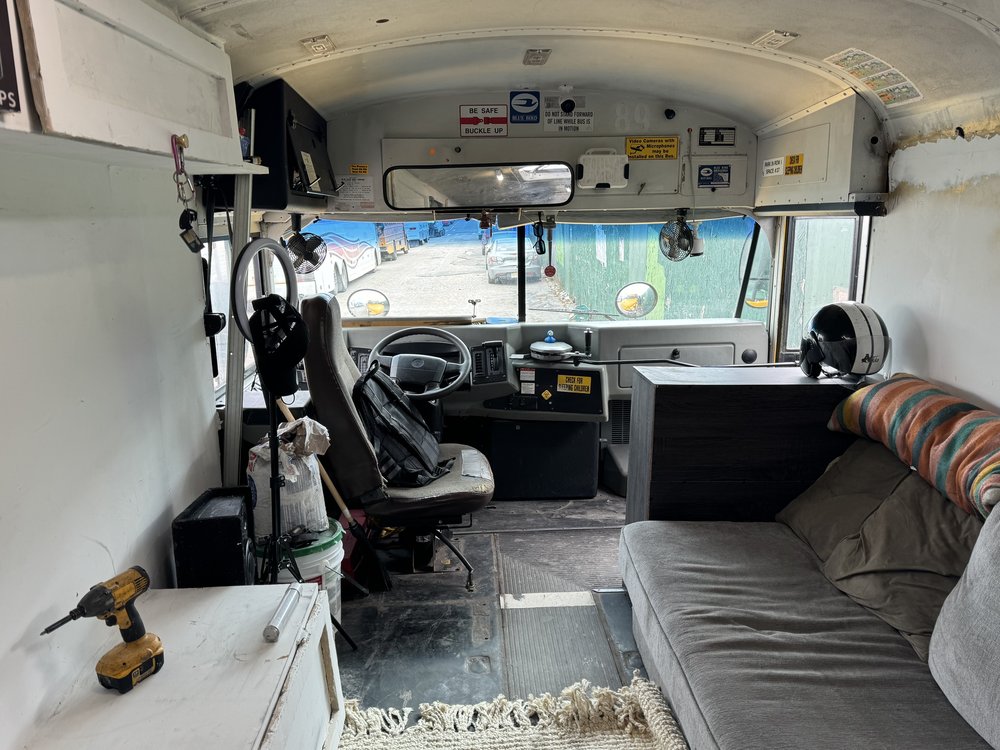
A growing majority of migrants and asylum-seekers who entered New York City’s shelters in an influx that began two years ago have since left the system. More than 110,000 of the nearly 180,000 migrants who came here during what has been described as the “busing chapter” in U.S. immigration history are no longer in the city’s care.
Mayor Eric Adams and administration officials have repeatedly touted these statistics in press conferences, pointing to what they call the “success” of their policies to curb the growing migrant population in shelters and cut costs, including controversial 30- and 60-day limits on migrant shelter stays. But the city doesn’t track where migrants who exit shelters land, and there are fresh questions about the well-being of newcomers who set out on their own.
Gothamist spoke to some of the migrants who have departed, who said they had relied on budding social networks — including fellow migrants, new acquaintances, and WhatsApp groups — to find off-the-books jobs and cramped apartments in outer boroughs and in cities across the country. Historians say they’re following in the footsteps of past generations of immigrants.
But migrants who have left the shelters also report that they had spent days or weeks unsheltered, undercutting Adams' recent assurances that “not one child, not one family, not one individual” had been forced to sleep on the street after being uprooted from a shelter. Their claims are backed up by housing and immigration advocates, as well as an internal report.
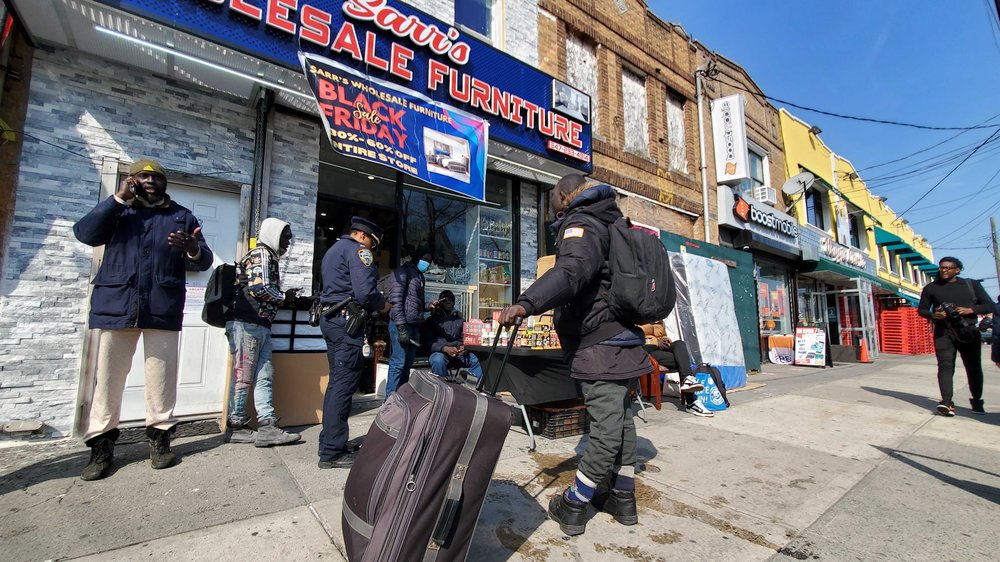
The migrants say they have slept outdoors, in trains, in crowded mosques, and sometimes substandard housing – a point driven home by the FDNY's discovery of 70 migrants living in the basement of a Queens furniture store on Monday, followed by the discovery of dozens more living in a cramped commercial space in the Bronx on Wednesday. Gothamist also found a migrant duo who left city shelters and opted to live in a parked school bus.
Adama Bah, the head of Afrikana, a nonprofit helping Black migrants, said she's aware of many migrants — more than she can count — who exited the shelter system and now find themselves sleeping in cars, trucks and other inhospitable places.
"They're in worse situations than they were before," Bah said.
Will Watts, the Coalition for the Homeless' advocacy director, said he worries some migrants have the wrong impression that they can’t reapply for shelter, or they’ve just given up because of the sometimes multiday waits outside the “reticketing center” for migrants seeking to return to the shelter system or arrange transportation elsewhere.
“One of the concerns is: Are they just not returning because they misunderstood, or not wanting to endure what others have had to endure?” Watts said.
Homeless while waiting
Adams pointed to what he described as the lack of street homelessness among migrants in a press conference on Tuesday as proof that his administration's efforts to curb the growing shelter population are succeeding.
"We're not seeing what you see in other cities where there are tent cities or where there are people living on the streets, children and families," Adams said. "I keep going back to that over and over again."
Adams added that as such a large volume of migrants exits the shelter system, "a small number... is going to do something inappropriate," referring to the FDNY's discovery of dozens of migrants living in the basement of a Richmond Hill furniture store.
But several migrants told Gothamist that they had slept in trains or on the street while waiting to reapply for shelter after receiving 30-day and 60-day notices to leave the shelter system in order to make way for new arrivals.
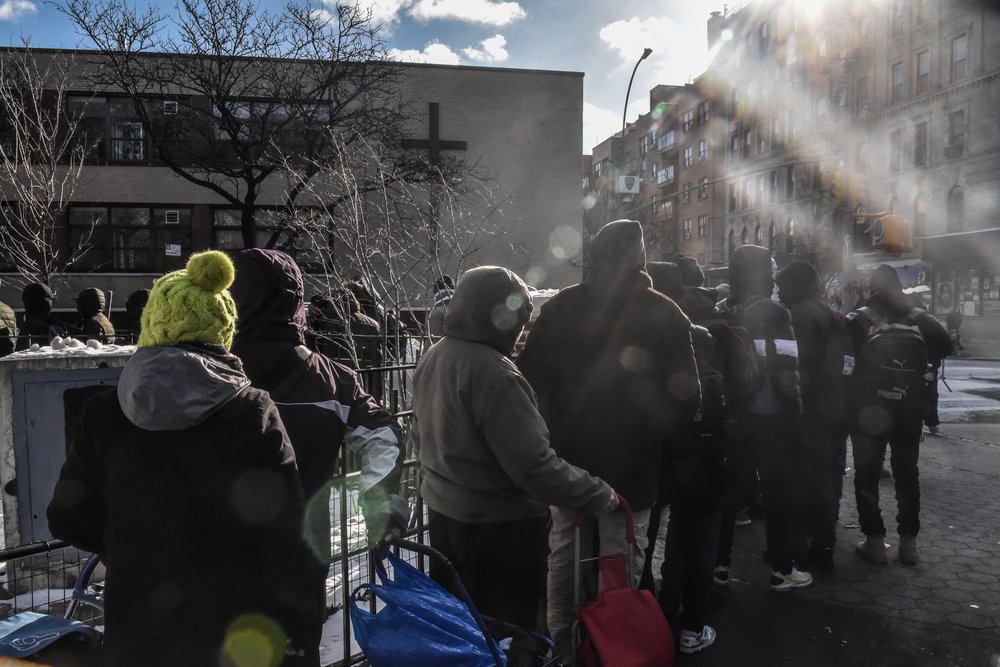
Fall, 43, from Senegal, who asked that his full name not be used due to fears of jeopardizing his immigration status, said he spent a couple nights at a train station in Jamaica, Queens, in December after he was forced to leave his shelter because he'd reached his 30-day limit.
"I didn't know what to do because I was overwhelmed and it was raining," Fall said in Wolof, a language commonly spoken in his native Senegal, through a translator. "I didn't know where I should go spend the night, so I just ended up spending the night there."
About 3,400 migrants were on a waitlist to reapply for shelter at the city’s reticketing center in the East Village as of last week, according to Kayla Mamelak, an Adams spokesperson. Those waiting to reapply for shelter are marked in city data as having left the shelter system until they are given another place to stay, she said, adding that they only account for a small fraction of the over 110,000 migrants who have departed city shelters.
An internal survey from mid-January found that nearly 1,000 migrants waiting for placement at the reticketing center in the East Village had slept in the street or on trains, according to the news outlet The City.
In response to concerns about migrants living in precarious conditions after exiting shelter, Mamelak echoed the administration’s long-standing pleas for more help from the federal government. She pointed to the need for expedited work permits, additional financial support for New York City, and a "comprehensive decompression and resettlement strategy."
"We need the federal government to finish the job they started," Mamelak said in a statement.
Living on a bus
Miguel, 25, and his girlfriend Alejandra, 19, who arrived in the city last spring and spent months shuffling between different shelters, now live in a school bus parked on a quiet side street on the banks of the East River in Brooklyn.
The Venezuelan migrants are homeless by the federal Department of Housing and Urban Development’s definition, which includes those who “live in a place not meant for human habitation,” like a car.
Miguel bought the bus for $3,000 from a stranger on Facebook, using money he scraped together from odd jobs in construction and food delivery. He renovated the interior with wood from construction sites, as well as furniture and appliances found on Facebook Marketplace. He removed the original bus seats, built a bed nook, and installed a sink and shower attached to five-gallon water jugs for clean, running water.
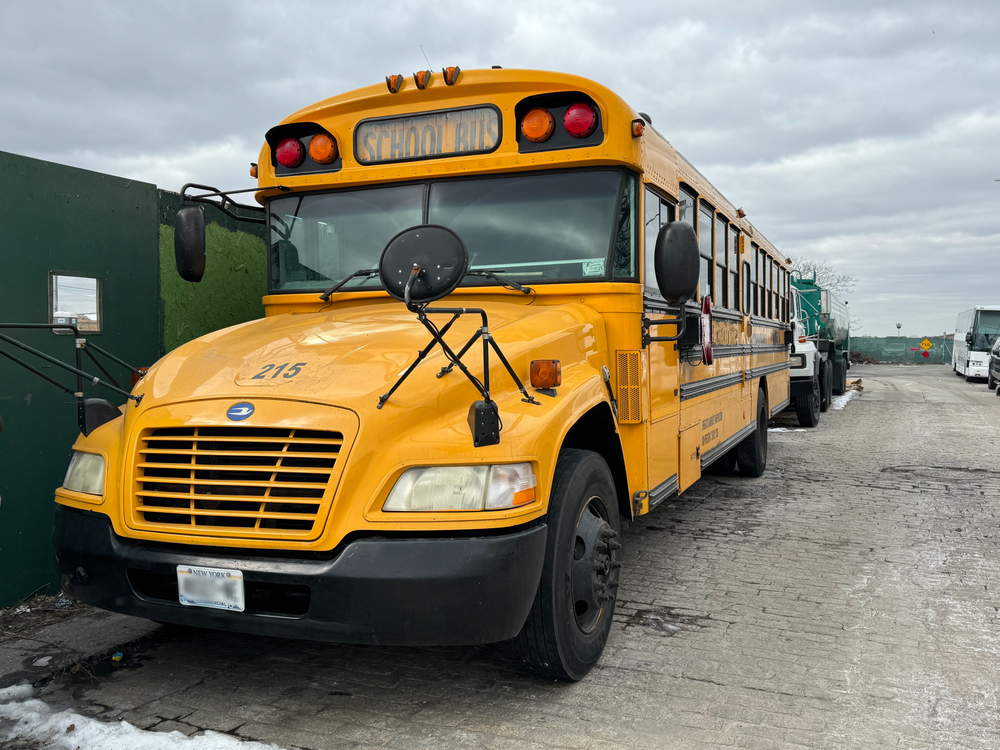
Miguel and Alejandra, who asked that their last names not be shared out of fear of jeopardizing their immigration case, said they spent their last days in the shelter system in a massive tent shelter on Randall’s Island, which they say was beset with fights and petty theft.
They bundle up in blankets to stay warm when the temperature dips at night.
"It's easy," Miguel said, laughing.
“It’s better than a shelter,” Alejandra said of her new bus home. “And sleeping on the street.”
Finding apartments on WhatsApp
Tyler Anbinder, a George Washington University professor who researches the history of immigration in New York, said the age-old process of migrants relying on their own social networks to find jobs and housing was “disrupted” when border-state governors began busing asylum-seekers in large numbers to places where they lacked social ties. Muzaffar Chishti, senior fellow and director of the Migrant Policy Institute at NYU's School of Law, calls this the “busing chapter” in U.S. immigration history.
“The way they've always found housing is using their social networks,” Anbinder said.
But now advocates say that migrants are finding jobs and housing through WhatsApp groups and even more distant acquaintances. For example, Fall found a fellow Senegalese roommate and a one-bedroom apartment in Jamaica, Queens, through a WhatsApp group for migrants who frequent a mosque in the Bronx.
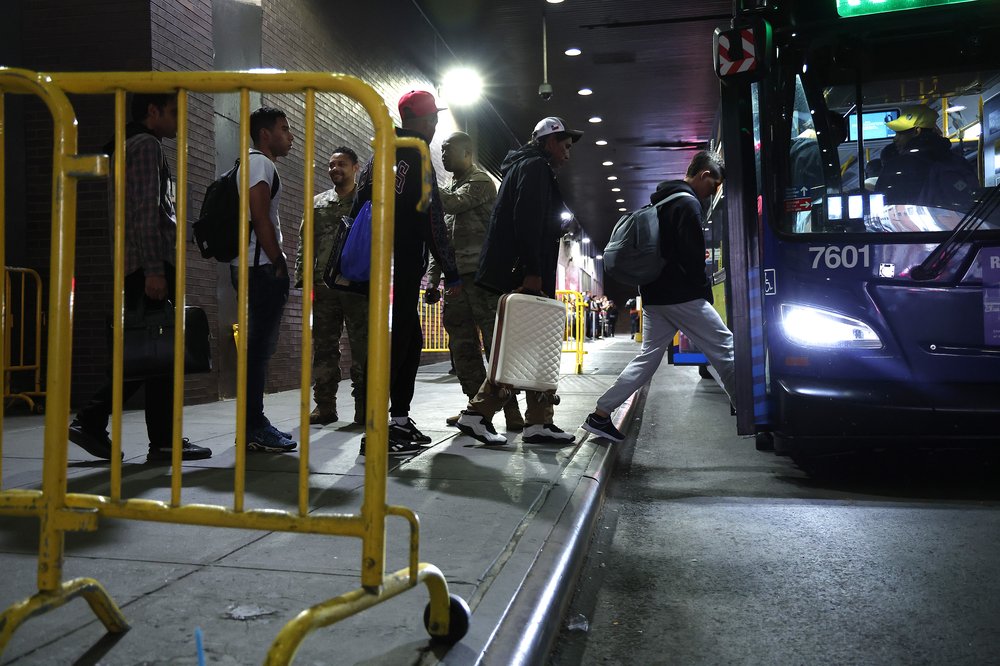
Savi Khalil, 32, another migrant who left the city’s shelter system, found a grocery-store cashier job and an apartment in Philadelphia thanks to a hometown acquaintance turned close friend.
Khalil said they had a “far relationship” and didn’t talk much back home in Mauritania. But they ran into each other and exchanged numbers at a tent shelter at the Creedmoor Psychiatric Center in Queens where they were both staying. After Khalil’s friend found a job in Philadelphia, they kept in touch, calling each other roughly every week — until one week in December, the friend called with a job lead for Khalil, too.
“It’s my close friend,” Khalil said. “I owe him. Because I was in a hard time. I was jobless.”
Now, in Philadelphia, Khalil’s boss lets him stay in a spare room in a two-bedroom apartment above a corner store. He earns $400 every week for 10-hour work days, six days a week. That’s roughly $6.7 per hour, far below the city’s $11-per-hour minimum wage.
“It’s way better [than] to stay without having a job,” Khalil said.
But Khalil said he still misses New York City, including buses that come more frequently, friends he’d go out with most nights, and the city's hustle and excitement. He barely sees his friend who got him the new job because they live an hour apart on opposite sides of town.
Crowded apartments
From the era of tenements to the modern day, the phenomenon of immigrants squeezing into overcrowded apartments “has been happening as long as immigrants have been in New York,” Anbinder said.
In 2021, 12% of immigrant households in New York City lived in crowded conditions, with two or more people per bedroom, compared to 8% of households in the city overall, according to an analysis of city housing data by the Community Service Society. And many new migrants are following suit, according to immigrant advocates.
Fall, the Senegalese man who once stayed in the Jamaica train station, is among them.
The sloped ceilings in Fall’s Jamaica apartment prevent him from standing fully upright in most of his bedroom, which is just large enough to fit a bed. He crouches to pull his clothes out of his suitcase. He shares the two-bedroom apartment with a roommate but struggles to make his portion of the $750 rent.
But Fall, who belongs to a growing wave of migrants coming to the city and country from West Africa, said his new apartment's occasional discomforts are far preferable to the shelters he relied on for months. He earns money by recycling bottles and carrying heavy items for customers at Home Depot, and occasionally receives help from family back home in Senegal.
“I love it here because I feel more responsible. I feel independent,” he said in Wolof through a translator. “If I compare it to the shelter, I think it’s actually a great place to be — until I’m able to move forward step by step to afford my own space.”
Over 28,500 tickets out of NYC
The city administration has also offered various incentives to get migrants to “take the next step on the journey in this country to pursuing the American dream,” as Adams recently put it.
Over 28,500 migrants have taken up the city’s offer of free airplane, train and bus tickets to other cities — which have cost the city over $7.6 million — with the hope of better job prospects and linking up with family and friends, according to Mamelak, the City Hall spokesperson. She added that top destinations include other New York cities and towns, Pennsylvania, Illinois, Colorado, Minnesota, Texas, Florida and various other southern states.
Miguel Alejandro Rojas Quero, 27, said he decided to accept the city’s offer for a plane ticket elsewhere in January, after he spent two weeks sleeping on trains while waiting for a new shelter bed.
The Venezuelan migrant had been staying in shelters since the summer, and said he had to leave and reapply three times after receiving 30- and 60-day notices to relocate.
He opted to fly to Charlotte, North Carolina, where his cousin had been living for years, and his brother moved to in the summer. His brother and cousin lacked extra space in their shared apartment, so Quero spent a week sleeping in Charlotte's airport before he found a room to rent with other migrants on Facebook Marketplace for $500 a month.
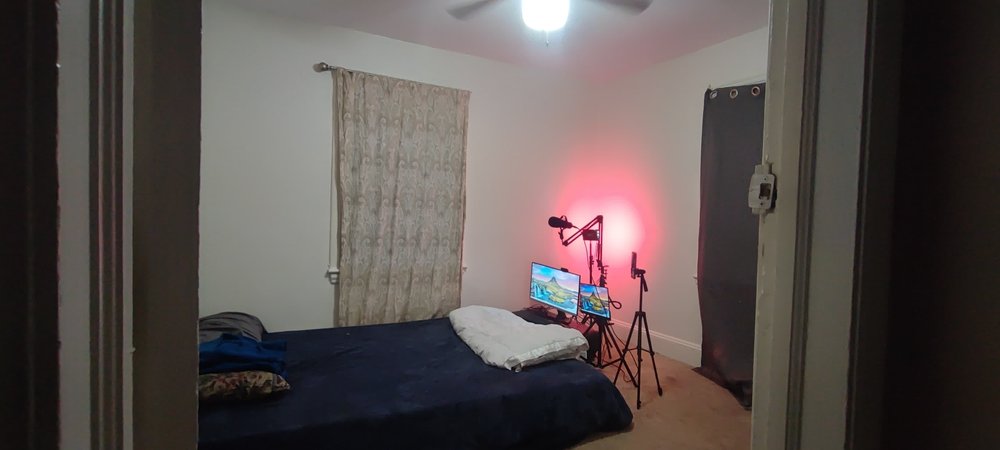
“Here, it’s calmer. The city’s prettier. Lots of trees,” he said of Charlotte, adding that he appreciates cooking his own arepas and other Venezuelan food, after months of living in congregate shelters without kitchens.
But not all migrants who have taken the city’s offer for travel tickets have spoken so highly of their new homes.
Before moving to Philadelphia, Khalil says he accepted a city-funded plane ticket to Detroit, where he didn’t have any friends or family. He said he slept on the street for a few days.
He had heard rumors he may be able to find a job in Michigan, and opted to leave New York because he was days away from being evicted from his shelter under the city’s 60-day limits.
“I didn’t find anything,” Khalil said. “Michigan was the worst place ever.”
Wolof translation for Fall provided by Mbacke Thiam of Afrilingual African Language Co-op.
Dozens of migrants in Queens allegedly found living in commercial basement NYC vacates another commercial property housing migrants How Mayor Adams and President Biden helped set the stage for immigration reform, however unwittingly In Harlem’s ‘Little Senegal,' West African migrants find community and challenges